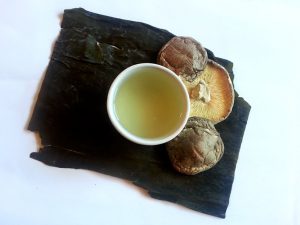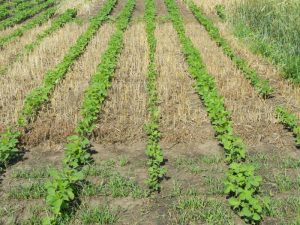in complete diets foods complement each other – here’s a dashi recipe
Go for complete diets not cherry picked ‘superfoods’, and whole foods rather than supplements.
As I mentioned before, when I used to ask the redoubtable Phillip Chu about various supplements he would reply, ‘Why? Trust your food!”
Chinese medicine prefers balanced diets with a range of healthy foods to over-emphasis on ‘superfoods’ and obsessive consumption of them, and it’s not particularly fond of extracted supplements.
But what about all those ginseng, royal jelly, and reishi mushroom pills in the Chinese pharmacy?’ you ask. While, just because someone wants to sell it to you doesn’t mean taking it is a good idea. The confusing and complicated story of soy and konbu supplements could be illuminating here.
You could write scientific papers about this but let’s try to keep it simple.
People noticed that the Japanese tend to be healthier than a lot of Westerners, and had a lower incidence of certain cancers such as breast cancer, but that the incidences of these in Japanese living in the West were higher. This made people think that diet could be a factor, and the higher consumption of soy products by Japanese was obvious. This led to recognition that soy products contain compounds called phytoestrogens that bind to cells in the same way that oestrogen does.The next thing you know there are pills and supplements containing these phytoestrogens with a number of claimed health benefits.
This is where it gets complicated: it is not clear whether the pytoestrogens stimulate the same responses as oestrogen does, or whether they reduce or regulate the effects of oestrogen in the body; and that this differs in various parts of the body, in people of different ages, and even between people with different lifelong or even intergenerational consumption of soy products.This is important because some cancers are affected by oestrogen, so would be encouraged if phytoestrogens acted like oestrogen, but weakened or prevented if they blocked the action of oestrogen.It is also possible that because they act like a hormone, but but are different from oestrogen, phytoestrogens could change the behaviour of cells in the body in unknown ways that oestrogen doesn’t. A further possible complication is that while soy products contain a number of phytoestrogens that could have slightly different actions and moderate or regulate the effects of each individual phytoestrogen, supplements generally contain one or two.
Even though Japanese women are less likely to get breast cancer than Westerners, it is was discovered that Western women who took soy supplements had increased levels of a hormone, IGF-1, that is associated with an increased risk of breast cancer. It turns out that consuming seaweed, as Japanese people also do, moderates the effect of soy on IGF-1 levels. [2]
Others have suggested that consuming soy may affect thyroid function, but this is unlikely if the dietary intake of iodine is sufficient, and seaweed which is an excellent source of iodine is recommended for those who consume soy products. [3]
It’s a mutually balancing relationship. Which is fortunate because konbu supplements with a range of claimed health benefits are popular – konbu is the Japanese word for kelp, a seaweed. Consuming too much seaweed can increase iodine levels so much that the thyroid becomes overactive and affects health. That this can happen has even been covered by the media. But in Japan where people consume a lot of seaweed, they do not tend to have excessive iodine levels, and it’s because of the soy consumption. It seems that consuming soy can moderate the uptake of iodine from seaweed.[4] Just as some possible adverse effects of eating too much soy are balanced by seaweed, the effects of eating to much seaweed are balanced by soy.
The Japanese have a variety of ways of using seaweed. Dried flakes of seaweed are sprinkled on rice, or made into a seasoning mix with sesame seed, dried tuna flakes, and salt as in furikake, or chopped and dressed as a seaweed salad. Sushi is wrapped in sheets of dried seaweed called nori, and this can also be shredded and added to rice. Then there’s the seaweed stock usually made from konbu, dashi, which is the base of miso soup and can be used to add savoury yumminess or umami to just about anything.
Some people prefer to use Japanese grown seaweeds as they think Chinese seaweeds are grown in more polluted waters.
Dashi is usually made with bonito flakes or katsuobushi, and these add a wonderful smokiness to the stock, but headless dried anchovies that are available from Chinese grocers are an easy and cheap alternative. I once made a dashi using the anchovies in oil that were in the fridge.
750ml room temperature water
15g konbu – about 12cm square
2 dried shitake mushrooms, soaked for 10 minutes
9g katsuobushi – a handful or so
Wipe the konbu with a damp cloth. Put it and the shitake mushrooms in water and heat until it is just starting to steam. Take it off the heat and rest for 1 hour, then take out the konbu. Heat again until it just starts bubbling, turn off the heat and drop the katsuobushi in and steep it for 5 minutes. Strain off the stock.
This can be make without the rest but the umami flavour will not be as developed. If using headless anchovies use a big handful and they can be simmered for a few minutes after the konbu is taken out.
You can off course, make miso soup from your dashi stock, and put some tofu in it.
- Rietjens I, Louisse J, and Beekmann K. The potential health effects of dietary phytoestrogens British Journal of Pharmacology 2017;174 1263-1280.
- Teas J, Irhimeh MR, Druker S, Hurley TG, Hébert JR, Savarese TM, Kurzer MS. Serum IGF-1 concentrations change with soy and seaweed supplements in healthy postmenopausal American women. Nutr Cancer. 2011;63(5):743-8.
- Messina M, Redmond G. Effects of soy protein and soybean isoflavones on thyroid function in healthy adults and hypothyroid patients: a review of the relevant literature.Thyroid. 2006 Mar;16(3):249-58.
- Munehiro Yoshida, Ayumi Mukama, Ryota Hosomi, Kenji Fukunaga. Soybean Meal Reduces Tissue Iodine Concentration in Rats Administered Kombu Biomedical Research on Trace Elements 2017;28(1) 28-34



Comments are Disabled